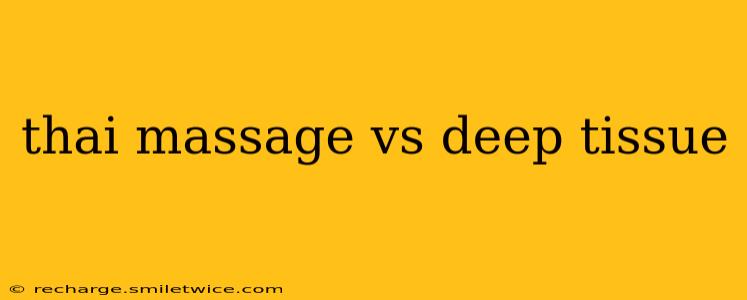Choosing between a Thai massage and a deep tissue massage can feel overwhelming. Both offer therapeutic benefits, but they target different needs and utilize distinct techniques. This comprehensive guide will break down the key differences, helping you decide which massage modality best suits your requirements.
What is Thai Massage?
Thai massage, also known as Thai yoga massage, is an ancient healing art originating in Thailand. It's a unique blend of acupressure, assisted stretching, and passive yoga. Unlike many other massage styles, Thai massage is performed on a floor mat, with the recipient usually wearing comfortable clothing. The practitioner uses their hands, elbows, knees, and feet to apply pressure to specific energy lines (Sen) in the body, promoting relaxation and improving energy flow.
Key Characteristics of Thai Massage:
- Focus: Energy flow, flexibility, and relaxation.
- Technique: Acupressure, assisted stretching, rocking, and compression.
- Pressure: Varies, from gentle to firm, depending on the client's needs and preferences.
- Environment: Typically performed on a mat on the floor.
- Clothing: Recipient usually wears comfortable clothing.
What is Deep Tissue Massage?
Deep tissue massage targets the deeper layers of muscle and connective tissue. It uses slow, deep strokes to release chronic muscle tension and pain. This type of massage is often beneficial for individuals experiencing muscle stiffness, pain from injuries, or repetitive strain injuries.
Key Characteristics of Deep Tissue Massage:
- Focus: Relieving chronic muscle tension and pain.
- Technique: Slow, deep strokes, friction, and kneading.
- Pressure: Firm and deep.
- Environment: Performed on a massage table.
- Clothing: Recipient usually undresses to their level of comfort, though draping is provided.
Thai Massage vs. Deep Tissue Massage: A Side-by-Side Comparison
| Feature | Thai Massage | Deep Tissue Massage |
|---|---|---|
| Goal | Improve energy flow, increase flexibility, relaxation | Relieve chronic muscle tension and pain |
| Technique | Acupressure, stretching, compression | Deep strokes, friction, kneading |
| Pressure | Varies, can be gentle to firm | Firm and deep |
| Clothing | Usually worn | Usually removed (draping provided) |
| Position | Floor mat | Massage table |
| Best for | Stress relief, increased flexibility, gentle muscle tension | Chronic pain, muscle stiffness, injury recovery |
What are the benefits of Thai massage?
Thai massage offers a multitude of benefits beyond simple relaxation. It can improve flexibility, range of motion, and circulation. Many find it helps alleviate stress, promote relaxation, and improve sleep quality. The focus on energy lines can leave clients feeling energized and balanced.
What are the benefits of deep tissue massage?
Deep tissue massage is particularly effective for addressing chronic muscle pain and stiffness. It can help break down scar tissue, reduce inflammation, and improve posture. It's often recommended for individuals recovering from injuries or those experiencing persistent muscle tension from repetitive movements.
Which massage is better for back pain?
The best massage for back pain depends on the underlying cause. If your back pain is due to chronic muscle tension or stiffness, deep tissue massage may be more effective. However, if your back pain is related to poor posture or limited flexibility, Thai massage's focus on stretching and energy flow may be more beneficial. In some cases, a combination of both might be most helpful.
Which massage is better for relaxation?
While both massage types can be relaxing, Thai massage often lends itself more readily to deep relaxation. The gentle rocking and rhythmic movements, combined with the focus on energy flow, can induce a state of profound tranquility. Deep tissue massage, while therapeutic, tends to be more intense and may not be as relaxing for everyone, especially during the session itself.
Is Thai massage good for athletes?
Yes, Thai massage can be very beneficial for athletes. It improves flexibility, range of motion, and helps prevent injuries by addressing muscle imbalances and tightness. The assisted stretching techniques can help athletes improve their performance and recover faster from workouts.
Which massage is more painful?
Deep tissue massage is generally considered more intense and potentially painful than Thai massage. The deep pressure used in deep tissue massage can cause some discomfort, especially in areas with significant muscle tension or injury. Thai massage, while it can involve some firm pressure, is often described as more invigorating and less painful overall. However, individual pain thresholds vary greatly.
In conclusion, the choice between Thai massage and deep tissue massage depends entirely on your individual needs and preferences. Consider your specific goals – whether you're seeking relaxation, pain relief, increased flexibility, or injury recovery – to determine which type of massage is right for you. Consulting with a qualified massage therapist can help you make an informed decision.
